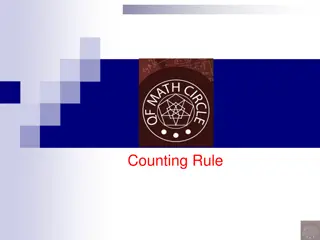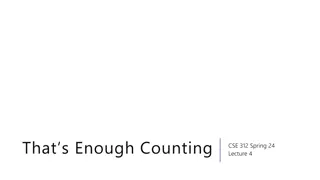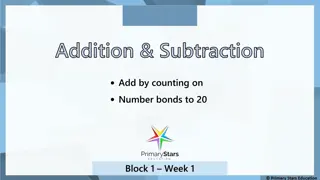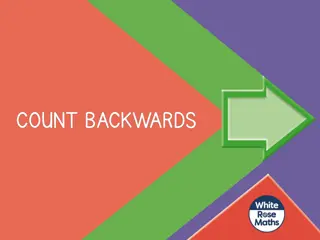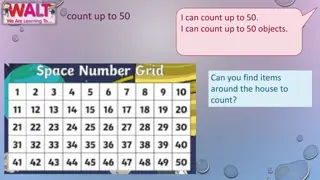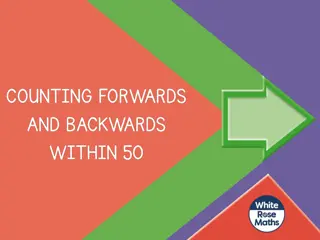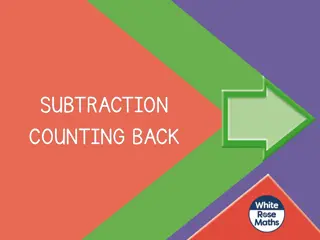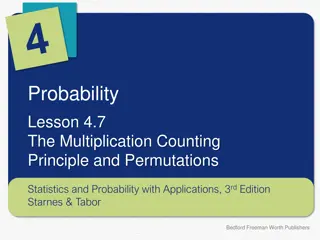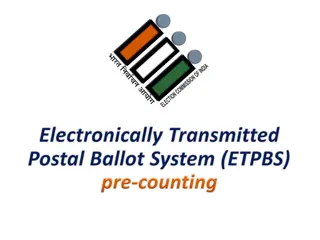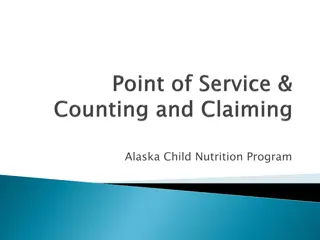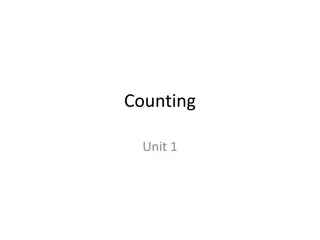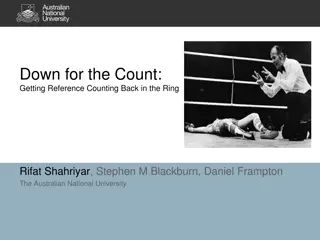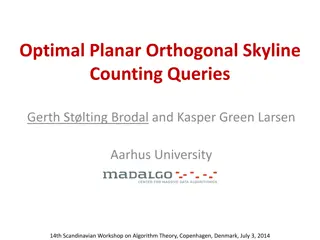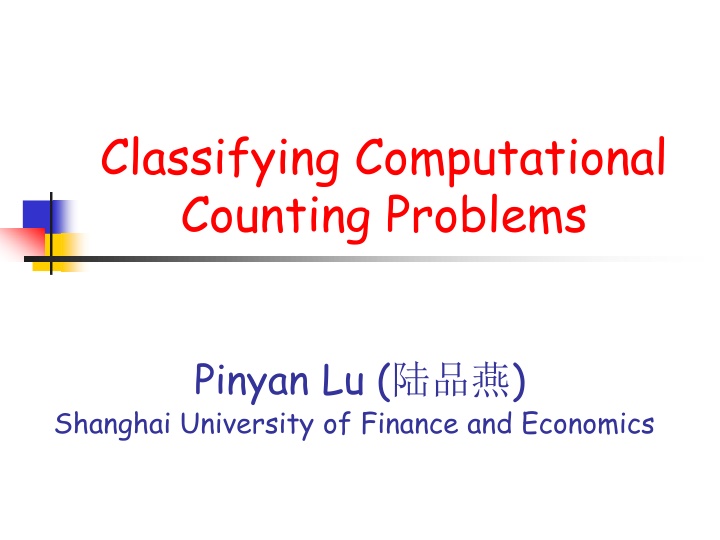
Computational Counting Problems and Complexity Classes Overview
Explore the world of computational counting problems, complexity classes, and dichotomy theorems through a comprehensive overview presented by Pinyan Lu from Shanghai University of Finance and Economics.
Download Presentation

Please find below an Image/Link to download the presentation.
The content on the website is provided AS IS for your information and personal use only. It may not be sold, licensed, or shared on other websites without obtaining consent from the author. If you encounter any issues during the download, it is possible that the publisher has removed the file from their server.
You are allowed to download the files provided on this website for personal or commercial use, subject to the condition that they are used lawfully. All files are the property of their respective owners.
The content on the website is provided AS IS for your information and personal use only. It may not be sold, licensed, or shared on other websites without obtaining consent from the author.
E N D
Presentation Transcript
Classifying Computational Counting Problems Pinyan Lu ( ) Shanghai University of Finance and Economics
Outline Complexity Classes and Counting Problems Dichotomy Theorems Holographic Algorithms Approximate Counting
Outline Complexity Classes and Counting Problems Dichotomy Theorems Holographic Algorithms Approximate Counting
Complexity Class P P is the complexity class containing decision problems which can be solved by a deterministic Turing machine using polynomial time. P "efficiently solvable" or "tractable .
NP NP is the set of decision problems solvable in polynomial time on a non-deterministic TM. Equivalently, it is the set of problems whose solutions can be "verified" by a deterministic TM in polynomial time. SAT, Hamiltonian cycle, Graph coloring
#P #P is the set of counting problems associated with the decision problems in the set NP, counting number of solutions. #SAT, #Hamiltonian Cycle, #Graph Coloring. #P is at least as difficult as NP.
Complexity Classes #? ?? ?
Complete Problems #? ??-Complete ?? ?
Complete Problems 3-Coloring #? ??-Complete ?? ?
Complete Problems 3-Coloring #? ??-Complete ?? 2-Coloring ?
Complete Problems 3-SAT 3-Coloring #? ??-Complete ?? 2-SAT 2-Coloring ?
Complete Problems 3-SAT 3-Coloring #? ??-Complete ?? 2-SAT 2-Coloring ?
Complete Problems 3-SAT 3-Coloring #? Vertex Cover ??-Complete Independent Set ?? 2-SAT 2-Coloring ?
Complete Problems 3-SAT 3-Coloring #? Vertex Cover ??-Complete Independent Set Perfect Matching ?? 2-SAT 2-Coloring Lin-q ?
Counting Problems #?-Complete #3-SAT #3-Coloring #? #Vertex Cover ??-Complete #Independent Set #Perfect Matching ?? #2-SAT #2-Coloring #Lin-q ?
Counting Problems #?-Complete #3-SAT #3-Coloring #? #Vertex Cover #Independent Set #Perfect Matching #2-SAT #2-Coloring #Lin-q ?
Counting Problems #?-Complete #3-SAT #3-Coloring #? #Vertex Cover #Independent Set #Perfect Matching #2-SAT #2-Coloring #Lin-q ?
Outline Complexity Classes and Counting Problems Dichotomy Theorems Holographic Algorithms Approximate Counting
Dichotomy Theorems #?-Complete #3-SAT #3-Coloring #? #Vertex Cover #Independent Set #Perfect Matching #2-SAT #2-Coloring #Lin-q ? #Planar Perfect Matching
Dichotomy Theorems #?-Complete #3-SAT #3-Coloring #? #Vertex Cover #Independent Set #Perfect Matching #2-SAT #2-Coloring #Lin-q ? #Planar Perfect Matching S??? ?????????
Graph Homomorphisms ?:?? ?? ?,? ?? ?(?),?(?) ?? ? ?
Graph Homomorphisms ?:?? ?? ?,? ?? ?(?),?(?) ?? ? ?
Graph Homomorphisms ?:?? ?? ?,? ?? ?(?),?(?) ?? ? ?
Graph Homomorphisms ?:?? ?? ?,? ?? ?(?),?(?) ?? ? ?
Graph Homomorphisms ?:?? ?? ?,? ?? ?(?),?(?) ?? ? ?
Graph Homomorphisms ?:?? ?? ?,? ?? ?(?),?(?) ?? ? ?
Dichotomy Theorem [Dyer, Greenhill 00] The counting graph homomorphisms problem is in P if each connect component of H is either a complete graph with self-loops or a complete bipartite graph; #P-complete otherwise.
Graph Homomorphisms ?:?? ?? ?,? ?? ?(?),?(?) ?? #3-coloring 0 1 1 1 0 1 1 1 0 H= ??? = H(vi,vj) ?1,?2, ,?? [?] ?,? ?
Weighted Graph Homomorphisms Spin systems in Statistic Physics Graphical models in machine learning 2 1 1 1 2 1 1 1 2 H= ??? = H(vi,vj) partition function ?1,?2, ,?? [?] ?,? ?
Weighted Graph Homomorphisms [Bulatov, Grohe 05] Let H be a symmetric non-negative matrix. Then it is #P-hard to compute the partition function unless each connect component of H is of rank 1 or bipartite rank 2. block-rank-one structure
Negative and complex weight? ? =1 1 was an obstacle for while 1 1 Quantum spin systems? Determinant vs permanent Surprising tractable families due to algebraic cancelation. ??? = H(vi,vj) ?1,?2, ,?? [?] ?,? ?
Real and complex weight [Goldberg, Grohe, Jerrum ,Thurley 08] Dichotomy for real weighted GH 1 1 1 ? =1 is tractable [Cai, Chen, L. 10] Dichotomy for complex weighted GH
Counting CSP ? is a family of constraints (functions) ?1,?2, ,?? are variables taking values from [?]. A function ? ? is applied on ??1,??2, ,???, where ?1,?2, ,?? [?] ?(??1,??2, ,???) ?1,?2, ,?? ? ?,?1,?2, ,?? ?
Boolean #CSP [Creignou, Hermann 96] All the functions in F take values in {0,1} (unweighted). [Dyer, Goldberg, Jerrum 07] non-negative values. [Bulatov, Dyer, Goldberg, Jalsenius, Richerby 09] real values. [Cai, L., Xia 09] complex values.
#CSP [Bulatov 08] Unweighted case [Dyer, Richerby 10, 11] Alternative proof and decidable dichotomy [Cai, Chen, L. 11] Non-negative weighted functions
Dichotomy for weighted #CSP [Cai, Chen, L. 11] The problem is #P-Hard unless any realizable function (after being viewed as a binary function) is of block-rank-1, in which case it is in P.
Further Classify the Hard Problems Some may become tractable when we have some restriction for the input instances. Some may become tractable if we are satisfied with an approximation answer. Some remains hard.
Outline Complexity Classes and Counting Problems Dichotomy Theorems Holographic Algorithms Approximate Counting
Counting for planar instances Counting Perfect Matchings (FKT algorithms) Counting planar CSP(???3) is in P Holographic Algorithms.
Holographic Algorithms by Valiant L. Valiant
A new algorithms design method Like linear programming, dynamic programming, and so on. Some seemingly exponential time computations can be done in polynomial time. Custom made exponential cancellations. It produces an exponential number of solution fragments in a pattern of interference, analogous to quantum computing.
A high level description Formulate the given problem as some vectors and the final value as an inter product of vectors. Find a basis transformation T such that the all these vectors (after transformation) can be encoded by some gadget on planar perfect matchings. Solve the problem by FKT algorithm
Art or Science? Accidental Algorithms [Valiant @ FOCS 2006] A strange new family of algorithms probes the boundary between easy and hard problems [An article from American Scientist Magazine]
Infinite Search Space Formulate the given problem as some vectors and the final value as an inter product of vectors. Find a basis transformation T such that the all these vectors (after transformation) can be encoded by some gadget on planar perfect matchings. Solve the problem by FKT algorithm
From Art to Science Joint with Jin-Yi Cai, we have Matchgate Identities [@CCC 2007] Basis Collapse Theorem [@ICALP 2007] A general algorithm to design holographic algorithms [@STOC 2007]
Three Trichotomy Theorems [Cai, L., Xia 10] #CSP for real symmetric functions ???????for real symmetric functions 2-3 regular Holant for complex symmetric functions
Trichotomy theorems Hard even for planar graphs Hard for general graphs but tractable for planar graphs by holographic algorithms Tractable for general graphs
Outline Complexity Classes and Counting Problems Dichotomy Theorems Holographic Algorithms Approximate Counting
Approximate counting Let ? > 0 and ? be the correct counting number of the instance, the algorithm returns a number ? such that 1 ? ? < ? < 1 + ? ?, in time ????(?,1 ?). This is called a fully polynomial-time approximation scheme (FPTAS). FPRAS is its randomized version.
Counting vs Distribution IS(G): the set of independent sets of graph G X is chosen from IS(G) uniformly at random ??? : the probability that ? is not in X 1 ?? ? Pr ? = = Pr ? = = Pr(?1?2 ?? ?) = Pr ?1 ? Pr ?2 ? ?1 ? Pr(?? ?|.) = ??1?1??2?2 ?????, where ?1= ?,??+1= ?? ??


